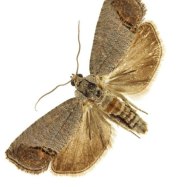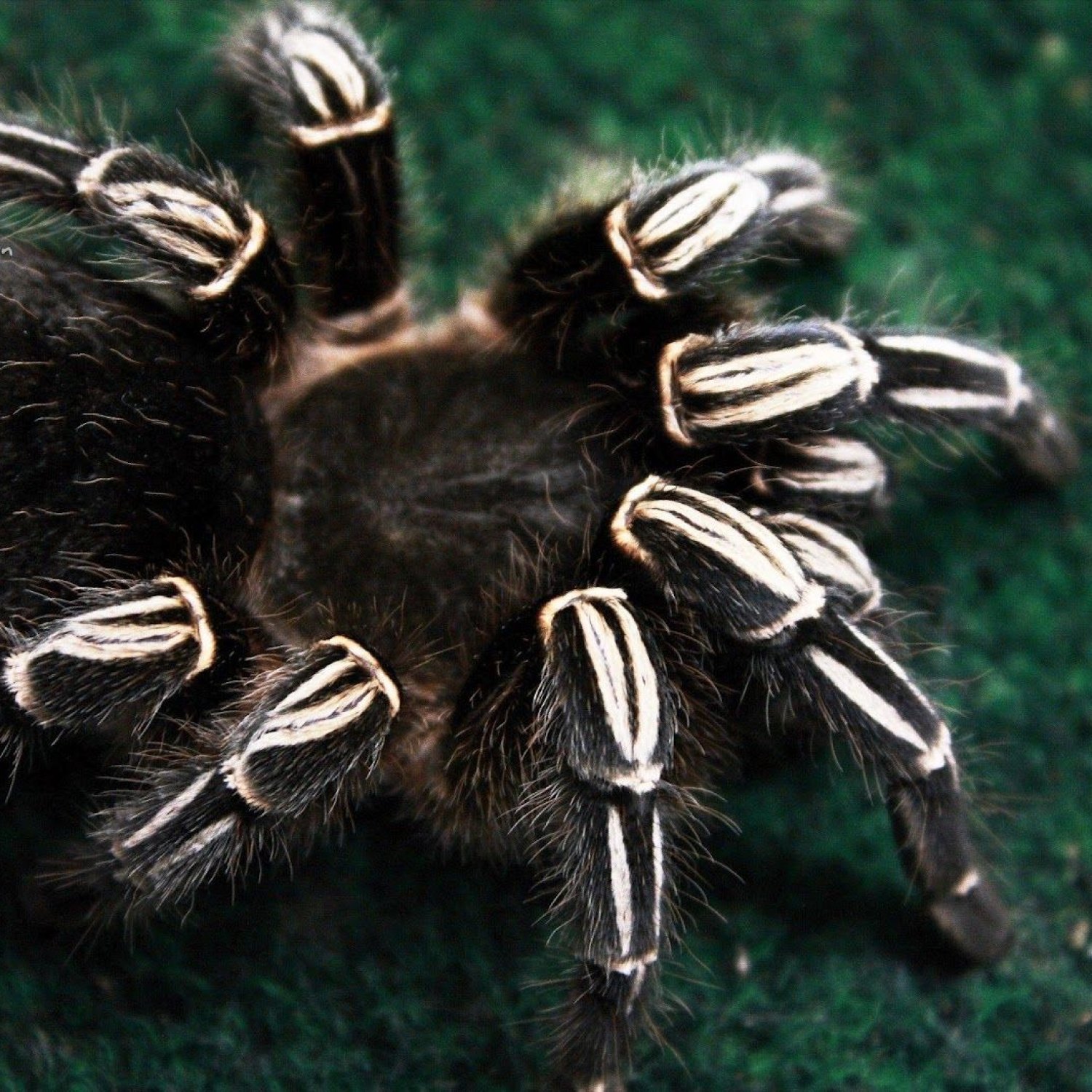
Zebra Tarantula
5-6 inches
The Zebra Tarantula is a fascinating creature found in tropical forests. These large and stocky spiders can grow up to 5-6 inches in length. Despite their intimidating appearance, they are docile and make interesting pets. As part of the Theraphosidae family, they have unique markings resembling a zebra, hence their name. Get to know more about these amazing spiders and their tropical habitat! #ZebraTarantula #TropicalSpiders #Theraphosidae #TropicalForests #FascinatingCreatures
Animal Details Summary:
Common Name: Zebra Tarantula
Kingdom: Animalia
Habitat: Terrestrial
The Zebra Tarantula: A Fascinating Creature of Central America
In the dense tropical forests of Central America, among the many species of spiders and insects, there is one creature that stands out with its striking appearance and intriguing behavior – the Zebra Tarantula. Scientifically known as Aphonopelma seemanni, this large and stocky spider belongs to the Theraphosidae family and is commonly referred to as the Zebra Tarantula due to its distinctive black and white stripes.With its unique characteristics and intriguing habits, the Zebra Tarantula is a fascinating creature worth exploring. So, let's dive into the world of this beautiful and elusive spider and discover what makes it stand out from the rest Zebra Tarantula.
Physical Features
The Zebra Tarantula is a sight to behold, with its black body adorned with white stripes, resembling the iconic animal it gets its name from. This coloration not only makes it stand out in the forest but also serves as a visual warning to potential predators. Its coloration is similar to that of the Zebra Longwing butterfly, with the black and white stripes serving as a defense mechanism against predators.Apart from its iconic stripes, the Zebra Tarantula has a large and stocky body, measuring around 5-6 inches in length. It has eight sturdy legs that help it navigate through its terrestrial habitat with ease. One of the interesting facts about the Zebra Tarantula is that it has tiny hairs on its body, which it uses as a defense mechanism against predators. When threatened, the spider will rub its legs and release these fine hairs, causing irritation to the skin and eyes of the predator.
Habitat and Distribution
The Zebra Tarantula is native to Central America, specifically Costa Rica and Panama, where it inhabits the tropical forests and jungles. Its terrestrial habitat is full of dark crevices, fallen logs, and burrows that provide the perfect hiding spots for this elusive spider Zokor. The Zebra Tarantula is a solitary creature and spends most of its time burrowed underground, only emerging at night to hunt for its prey.In recent years, due to human activities like deforestation, the Zebra Tarantula's habitat has been threatened, and its distribution has become limited to specific areas within Central America. This has led to the species being classified as vulnerable on the International Union for Conservation of Nature's (IUCN) Red List.
Diet and Feeding Behavior
As a carnivorous creature, the Zebra Tarantula's diet mainly consists of insects like crickets, grasshoppers, and other small arachnids. It is an opportunistic predator, meaning it will capture and feed on any prey that comes its way. Using its strong legs and sharp fangs, the spider catches its prey and injects venom that paralyzes it. This venom is primarily used to kill prey and is not harmful to humans unless they have an allergic reaction to it.One of the most interesting aspects of the Zebra Tarantula's feeding behavior is its method of digestion. Instead of consuming its prey like most spiders, it uses its digestive enzymes to liquefy the prey's tissues and then suck it out, leaving behind an empty shell. This method of digestion allows the spider to extract as many nutrients as possible from its food, ensuring its survival in its nutrient-scarce habitat.
Behavior and Reproduction
The Zebra Tarantula is a solitary creature and only comes into contact with other spiders during the mating season, which typically occurs in the spring. Males will use their sense of smell to find females, and once a suitable mate is found, they will perform a specific courtship dance to attract the female's attention.One of the most fascinating behaviors of the Zebra Tarantula is its ability to regenerate lost body parts. In case of a predator attack or injury, the spider has the remarkable ability to regrow lost legs, making it an incredibly resilient creature.
Females, unlike males, have a more extended lifespan of around 15-25 years, while males typically live for 3-5 years. Once the female has mated, she will lay around 100-1000 eggs, which she will carry with her until they are ready to hatch. This maternal care is an essential aspect of the Zebra Tarantula's behavior, ensuring the survival of the offspring.
Significance in Nature
The Zebra Tarantula plays a significant role in the ecosystem of Central America. As predators, they help keep insect populations in check, ensuring ecological balance. Their burrowing behavior also helps aerate the soil, making it better for the growth of plants.Moreover, the Zebra Tarantula is considered a keystone species, meaning their presence is vital to the survival of many other species in the ecosystem. They provide a source of food for other predators like birds and snakes, and their burrows provide shelter for other animals.
In Captivity
The Zebra Tarantula is a popular pet among exotic pet lovers. Due to its beautiful appearance and relatively low maintenance, it has become a sought-after species in the pet trade. However, it is essential to note that they are not domestic pets, and proper care must be taken when keeping them in captivity.If you are considering getting a Zebra Tarantula as a pet, it is essential to research thoroughly and understand the species' needs and behaviors. Captive-bred spiders are preferred, as this helps reduce the impact on the species' wild population.
In Conclusion
In conclusion, the Zebra Tarantula is an intriguing creature with unique characteristics that make it stand out in the dense forests of Central America. With its iconic black and white stripes, it serves as a visual warning to potential predators, along with its ability to regenerate lost body parts and its behavior of liquefying prey for digestion.While its distribution and habitat may be threatened, the Zebra Tarantula's significance in nature cannot be ignored. As a keystone species, it plays a vital role in maintaining ecological balance, making it an essential part of the delicate ecosystem of Central America.
So, the next time you come across a Zebra Tarantula in the wild or in captivity, take a moment to appreciate this fascinating creature and all that it contributes to the natural world.

Zebra Tarantula
Animal Details Zebra Tarantula - Scientific Name: Aphonopelma seemanni
- Category: Animals Z
- Scientific Name: Aphonopelma seemanni
- Common Name: Zebra Tarantula
- Kingdom: Animalia
- Phylum: Arthropoda
- Class: Arachnida
- Order: Araneae
- Family: Theraphosidae
- Habitat: Terrestrial
- Feeding Method: Carnivorous
- Geographical Distribution: Central America
- Country of Origin: Costa Rica and Panama
- Location: Tropical forests
- Animal Coloration: Black with white stripes
- Body Shape: Large and stocky
- Length: 5-6 inches
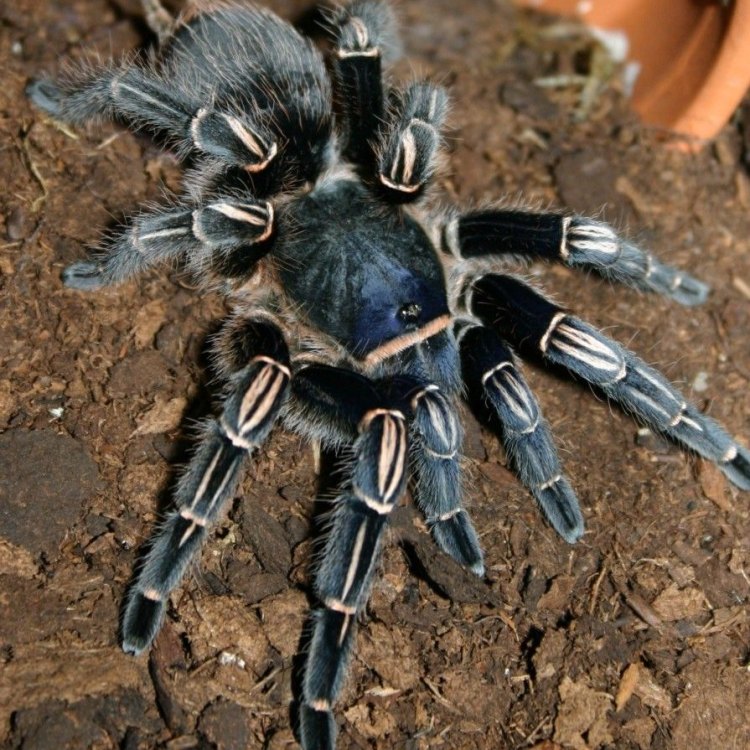
Zebra Tarantula
- Adult Size: 6-7 inches
- Average Lifespan: 10-15 years
- Reproduction: Sexual
- Reproductive Behavior: Males court females with drumming and leg tapping
- Sound or Call: None
- Migration Pattern: Non-migratory
- Social Groups: Solitary
- Behavior: Nocturnal and burrowing
- Threats: Habitat loss and collection for pet trade
- Conservation Status: Not evaluated
- Impact on Ecosystem: As predators, they help control insect populations
- Human Use: Collected for the pet trade
- Distinctive Features: Distinct black and white striped pattern on the abdomen
- Interesting Facts: They have urticating hairs on their abdomen that they can flick at potential predators
- Predator: Birds, reptiles, and mammals
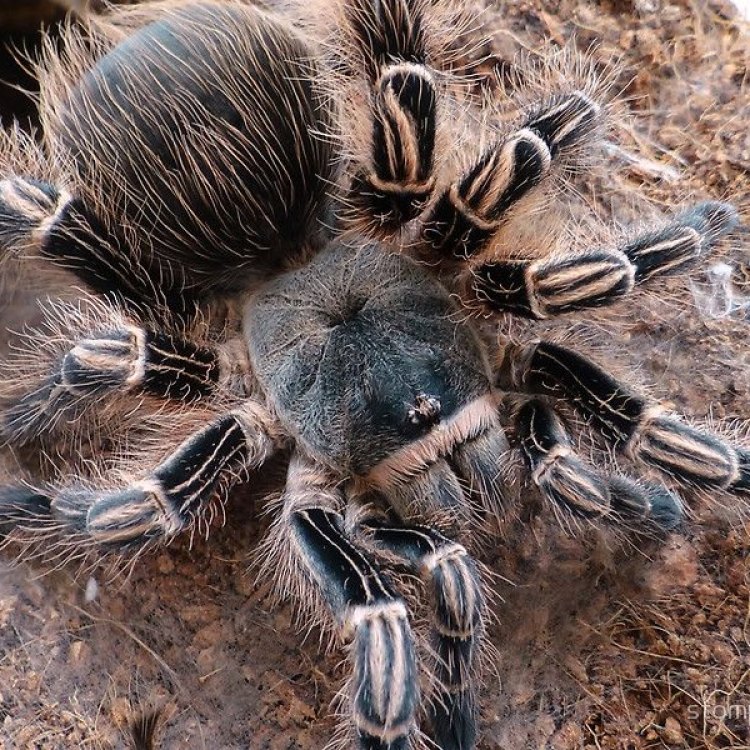
Aphonopelma seemanni
The Fascinating Zebra Tarantula: A Striped Wonder of the Arachnid World
When you think of a tarantula, you may picture a large, hairy, and intimidating spider. But have you ever heard of the zebra tarantula? With its distinctive black and white striped pattern on the abdomen, this tarantula is anything but ordinary. In this article, we will explore the unique features and behaviors of this fascinating arachnid, from its adult size and lifespan to its reproductive behavior and impact on the ecosystem.Adult Size and Lifespan
The zebra tarantula, also known as the Eupalaestrus campestratus, is a medium-sized tarantula that reaches an average size of 6-7 inches as an adult PeaceOfAnimals.Com. For comparison, this is slightly larger than a standard-sized smartphone.
But don't let its size fool you, this tarantula can live for an impressive 10-15 years in captivity, making it a long-term commitment for potential owners. However, in the wild, their lifespan may vary depending on environmental factors and potential threats.
Reproduction and Reproductive Behavior
Like most spiders, the zebra tarantula reproduces sexually. Males will typically approach a female's burrow, using their sense of touch and smell to locate her. They will then court the female through drumming and leg tapping, signaling their intentions to mate.
If the female accepts the male's courtship, she will lay eggs that will develop into spiderlings. Female tarantulas can lay hundreds of eggs, but the survival rate for spiderlings is low, as they are vulnerable to predators and environmental conditions.
Sound or Call: None
Unlike many other species of tarantula, zebra tarantulas do not produce any sound or calls as a means of communication Zebra Finch. Instead, they rely on their heightened senses, such as touch and smell, to interact with their surroundings.
Migration Pattern and Social Groups
Zebra tarantulas are non-migratory, meaning they do not move from place to place in search of food or shelter. They prefer to live in their burrows and remain within their territory, also known as their home range.
These tarantulas are solitary creatures, meaning they do not form social groups or colonies. They prefer to live and hunt alone, only coming together during the breeding season.
Behavior: Nocturnal and Burrowing
As with most tarantulas, zebra tarantulas are nocturnal, which means they are most active at night. During the day, they will usually retreat to their burrows to avoid the heat and potential predators.
These arachnids are also known for their burrowing behavior, as they use their powerful legs and sharp fangs to dig deep burrows in the ground. These burrows not only provide shelter but also help regulate the tarantula's body temperature.
Threats and Conservation Status
Just like many other species in the animal kingdom, the zebra tarantula faces threats in its natural habitat. One of the most significant threats is habitat loss due to human activities such as deforestation and urbanization. As their habitats diminish, these tarantulas have fewer places to hide and hunt, making them more vulnerable to predators.
Another threat comes from the pet trade, as these tarantulas are often collected and sold as pets for their unique appearance. While it is legal to collect and own zebra tarantulas in most countries, it is essential to ensure that they are sustainably sourced and bred in captivity to avoid contributing to their decline in the wild.
Currently, the conservation status of the zebra tarantula is not evaluated due to a lack of comprehensive data. However, their population may be declining in some areas, highlighting the need for further research and conservation efforts.
Impact on the Ecosystem
As predators, zebra tarantulas play a crucial role in maintaining the balance of insect populations in their habitats. By preying on insects, they help control their population sizes, preventing potential infestations and outbreaks.
These tarantulas also serve as prey for larger animals such as birds, reptiles, and mammals, forming an essential part of the food chain in their ecosystem.
Human Use: Collected for the Pet Trade
While some may fear or dislike tarantulas, they are fascinating creatures that have gained popularity in the pet trade. Due to their unique appearance and relatively low maintenance, zebra tarantulas are a sought-after species for pet owners.
However, owning a tarantula as a pet is not for everyone. These animals require a proper habitat, specialized care, and specific diets, making them a more challenging pet to care for compared to a cat or dog. It is crucial to do thorough research and consult with experienced owners before considering a zebra tarantula as a pet.
Distinctive Features and Interesting Facts
The most striking feature of the zebra tarantula is, of course, its distinctive black and white striped pattern on the abdomen. These stripes serve as a warning to potential predators, signaling that they may be dangerous or venomous.
But that's not the only defense mechanism this tarantula has. They also have urticating hairs on their abdomen that they can flick at predators or irritants, causing a burning sensation. While the effects may be uncomfortable for humans, these hairs serve as a potent defense mechanism for the tarantula.
Another interesting fact about the zebra tarantula is that they are able to regenerate lost limbs, a common occurrence for many species of tarantula. This incredible ability allows them to survive potential injuries or attacks from predators.
Conclusion
From its unique appearance to its fascinating behaviors and impressive lifespan, the zebra tarantula is truly a remarkable creature that deserves our attention and respect. As humans continue to encroach on their habitats and collect them for the pet trade, it is essential to educate ourselves and others on how to responsibly interact with these animals.
As we learn more about the zebra tarantula and its role in maintaining the delicate balance of ecosystems, we can appreciate them as a vital part of our natural world and work towards their conservation and protection.
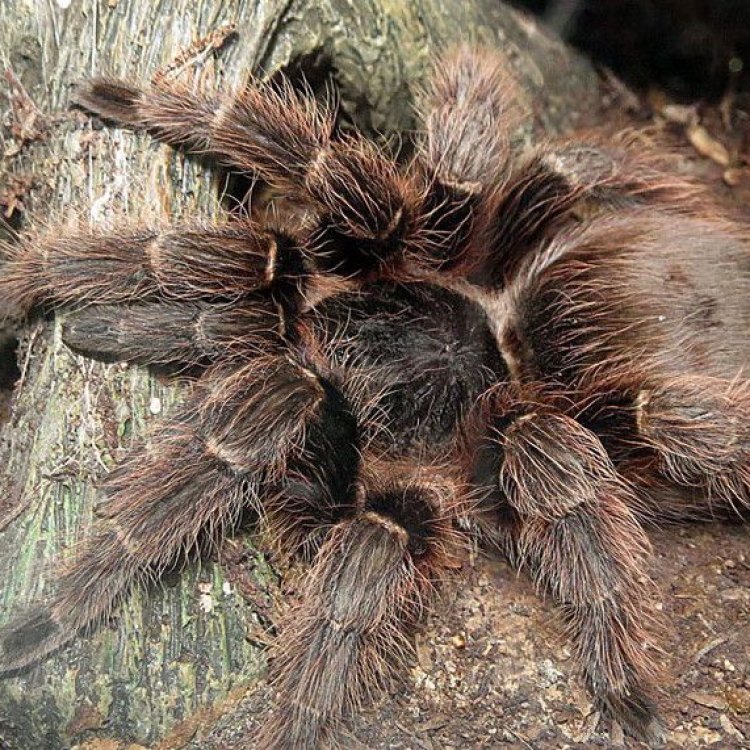
The Zebra Tarantula: A Fascinating Creature of Central America
Disclaimer: The content provided is for informational purposes only. We cannot guarantee the accuracy of the information on this page 100%. All information provided here may change without prior notice.





